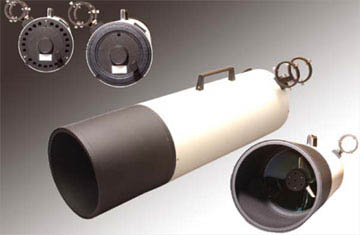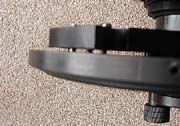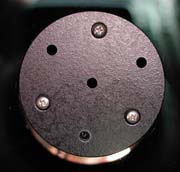

Now sold, December 2007.
To complete the line up for my new Gemini G41 mount I wanted a longer focal length and larger aperture than the excellent TMB refractor. My LX90 had been a good friend for four years, and although the optics were very good for a mass produced Schmidt Cassegrain, to reuse the tube effectively meant scrapping the fork mount and drives. A waste, and unnecessary when there were better quality tubes available to purchase on their own.
I eventually settled for a Russian STF Mirage 8" f/10 Maksutov Cassegrain from Bray Imaging. Originally a 1/6th wave, but in the end it turned out to be 1/10 wave (for a bit more money!)
The 'scope was initially promised for May 2004, but didn't finally appear until August. Nevertheless it was worth the wait, with superb views and crisp pinpoint stars.
First starlight (I'd had a brief peek at the Sun) was at the August 2004 Scarborough Star Fest in Dalby Forest, Yorkshire. Unfortunately the weather was unkind, and the clear skies didn't last very long. However on 16th. August a reasonably clear sky was available at Hexham, and I was able to compare the STF with the Meade LX90. And it proved to be worth the money!! I then set to and imaged the Bubble Nebula (NGC 7635) in Cassiopeia, previously imaged with my TMB Refractor, and obtained a pleasing image, despite occasional thin clouds moving across. Since then the telescope has provided many excellent images, this M51 being a good example of what it can produce, even in the UK!
|
With my Stellarvue AT1010 set on one side of the main tube in a GuideStar mount, my Helios1 Solar Scope in tube rings on the other side, and the main tube fixed with a dovetail clamp so that I can easily change between the TMB refractor and the Mirage, my line up is complete. |
|
Both primary and secondary mirrors can be adjusted for collimation with push-pull screws. |


|
Because the telescope is permanently located in my Observatory, and therefore close to ambient at all times, I have not experienced any cooldown problems, and have not found it necessary to use the fan.